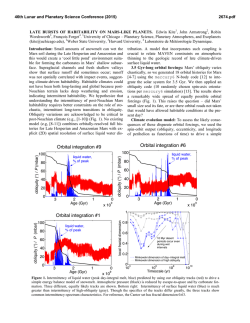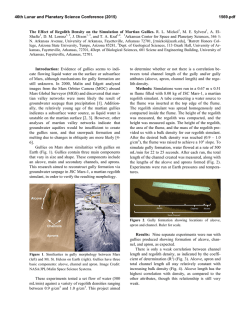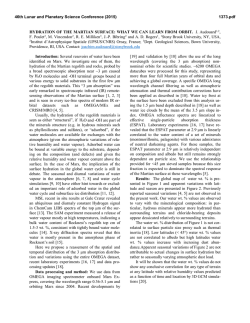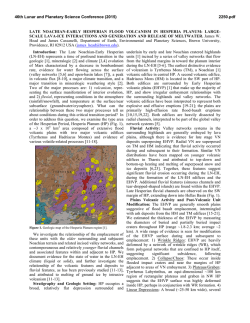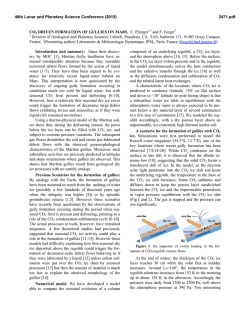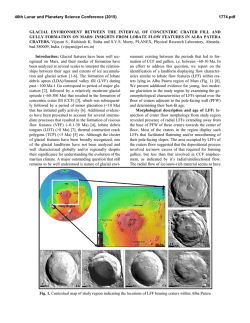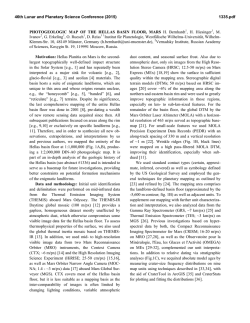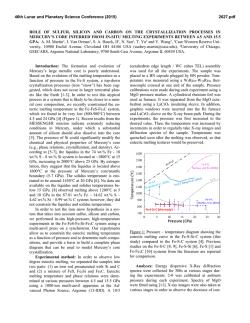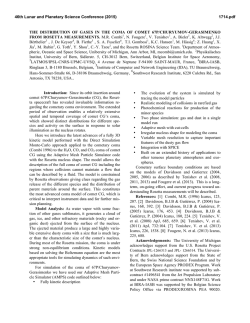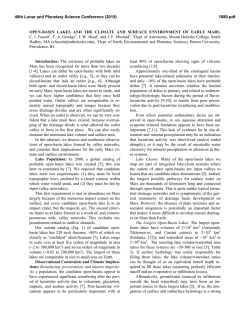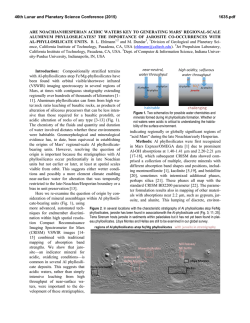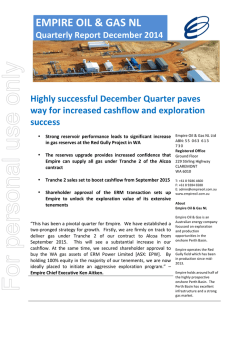
formation of gullies on mars by water at high obliquity
46th Lunar and Planetary Science Conference (2015) 1035.pdf FORMATION OF GULLIES ON MARS BY WATER AT HIGH OBLIQUITY: QUANTITATIVE INTEGRATION OF GLOBAL CLIMATE MODELS AND GULLY DISTRIBUTION. J. L. Dickson1, L. Kerber2, C. I. Fassett3, J. W. Head1, F. Forget4 and J-B. Madeleine4, 1Dep. Earth, Env. & Planet. Sci., Brown U., Providence, RI, 02906, USA, [email protected]; 2Jet Propulsion Laboratory, Pasadena, CA, 91109; 3Mt. Holyoke College, South Hadley, MA, 01075; 4Laboratoire de Meteorologie Dynamique, UPMC, Paris, France. Introduction: The latitude-dependent distribution [1-4] and non-uniform orientation [5-9] of gullies on Mars indicate that their formation is controlled by climate conditions at the surface within the last million years [10-11], while their global distribution [2,4] and morphology [12-13] show direct correlations with the ice-rich Latitude Dependent Mantle (LDM), a potential source for melting. Contemporary activity in gullies occurs at times that are consistent with the removal of CO2 frost, leading to destabilization of loose material on steep slopes [14-17]. While this activity is capable of mobilizing fines within existing gully channels, the potential for this process to form new gully systems is unclear. In particular, this activity may not explain (1) gullies that exhibit sinuosity values in excess of what what is measured for dry channels on Earth [18], (2) gullies with alcove slopes below 25° [8], and (3) channels that incise through tens of meters of permafrost [19]. These properties suggest that many gullies may be initiated by flows that are comprised by some percentage of fluid, the most reasonable candidate for testing being liquid water [12,20-22]. Global Climate Model (GCM) simulations show that regions where liquid water could exist today are poorly correlated with gully locations [23], with the majority of gullies occuring at elevations with surface pressure below the triple point of H2O [8]. Melting of ice within 50 cm of the surface in the mid-latitudes is predicted at ~35° obliquity [20, 22], a scenario that has occurred within the last million years [24]. Ice is predicted to accumulate in the mid-latitudes at 35° obliquity [25], providing a replenishable source [4, 13]. Further, recently discovered massive CO2 units presently sequestered in the South Polar Layered Deposits (SPLD) would be mostly sublimated at 35° obliquity, yielding average surface pressures > 10 mb [26]. This new information prompted us to quantitatively reassess the potential for liquid water at the surface at gully locations formed within the last million years. Methods: Simulations using the Laboratoire de Météorologie Dynamique (LMD) GCM [27] were run for three separate starting conditions thought to have occurred within the last million years [23]. (1) Present day (25° obliquity, 6 mb atmosphere); (2) ~380 kyr transitional scenario (30°, 8 mb); (3) ~625 kyr high-obliquity (35°, 10 mb). Age/obliquity values are from [24] and globally average pressure values are from [26], which calculat- ed pressure using the NASA Ames GCM [23]. The model ran for 4 Mars years before values were obtained for one Mars year, with 8 timesteps recorded per sol (total of 5352 timesteps). GCM outputs (3.75° (lat) x 5.625° (lon) cell size) were imported into a Geographic Information System (GIS) that contained a new detailed map of gullies in the southern hemisphere based upon Context Camera (CTX) data [28] (Fig. 1a). GCM cells were filtered to include only those that overlap with gully locations (Fig. 1b-d). Analysis of model outputs followed the principles of Haberle et al., 2001 [23] with regard to quantifying GCM timesteps when a given cell achieved conditons above both 273 K and 6.1 mb. Boiling of water was not considered in this analysis, as the focus was on how many instances predicted the onset of melting, not the duration that meltwater remained on the surface. Timesteps at which transient melting was possible were counted (Figure 1). This yielded the first direct quantitative assessment of liquid water potential at mapped gully locations. Results: At present (25° obliquity), conditions for melting in the southern hemisphere are constrained primarily by elevation and secondarily by latitude (Fig. 1b). In the southern hemisphere, only the margins and floors of Hellas and Argyre surpass the triple point of H2O, consistent with the predictions of Haberle et al., 2001 [23]. Melting conditions are found in the northern hemisphere, though surface pressures are lowest during northern summer, when peak daytime temperatures are at their highest. During transitional periods (30° obliquity), melting conditions are still constrained by elevation; highlatitude (~70°S) lows experience periods above the triple point; low-latitude highs (e.g. southern Thaumasia) do not (Fig. 1c). Newton crater (43°S, 160°E), a regional low characterized by thick ice deposits and densely concentrated and well-incised gullies [13, 29], frequently surpasses the triple point in this scenario. At high obliquity (35°), conditions above the triple point are achieved at all locations where gullies are mapped in the southern hemisphere (Fig. 1d). Unlike the first two scenarios, conditions for transient melting are latitude-dependent and exhibit no dependence on elevation. Even gullies that are mapped at polar latitudes experience > 50 timesteps of surface temperatures > 273 K. Previous calculations using the same 46th Lunar and Planetary Science Conference (2015) GCM showed that steep pole-facing slopes in the midlatitudes, where gullies preferentially occur [5-9], receive greater insolation at 35° obliquity than surrounding surfaces [20], suggesting that temperature calculations reported here may be minimum estimates. Discussion: The model results presented here are consistent with the independent model of Haberle et al., 2001 [23] for present day conditions: meltwater production on the surface of Mars today is unlikely, even if there was a source of volatiles to melt, in all locations, except the major impact basins in the southern hemisphere. This is also consistent with gully activity observed today being related to CO2 frost [1417]. However, our results suggest that melting of water ice was considerably more viable as an erosive agent during recent high-obliquity excursions, coincident with periods when ice accumulation is predicted to have occurred at gully locations [4, 25]. GCM results argue for a scenario of gully evolution that is reflected by their detailed morphology [30]: formation by liquid H2O at high-obliquity followed my modification and erosion by CO2-related processes at low obliquity. This process is predicted to be cyclical, consistent with morphologic evidence for episodic gully activity [30-31]. References: [1] Malin and Edgett, 2000, Science, 288, 2330. [2] Milliken et al., 2003, JGR, 108, 10.1029/2002JE002005. [3] Harrison et al., 2014, 8th Mars, 1030. [4] Head et al., 2003, Nature, 426, 797. [5] Heldmann and Mellon, 2004, Icarus, 168, 285. [6] Balme et al., JGR, 111, E05001. [7] Bridges and Lackner, 2006, JGR, 111, E09014. [8] Dickson et al., 2007, Icarus, 188, 315. [9] Kneissl et al., 2010, EPSL, 294, 357. [10] Reiss et al., 2004, JGR, 10.1029/2004JE002251. [11] Schon et al., 2009, Geology, 37, 207. [12] Christensen, 2003, Nature, 422, 45 [13] Head et al., 2008, PNAS, 105, 13258. [14] Dundas et al., 2010, GRL, 10.1029/2009GL041351. [15] Diniega et al., 2010, Geology, 38, 1047. [16] Dundas et al., 2014, Icarus, 10.1016/j.icarus.2014.05.013. [17] Raack et al., 2014, Icarus, 10.1016/ j.icarus.2014.03.040. [18] Mangold et al., 2010, JGR, 10.1029/2009JE003540. [19] Hobbs et al., Geomorphology, 226, 261. [20] Costard F. et al., Science, 295, 110. [21] Hecht, M., 2002, Icarus, 156, 373.. [22] Williams et al., 2009, Icarus, 196, 565. [23] Haberle et al., 2001, JGR, 106, 23317. [24] Laskar et al., 2004, Icarus, 170, 343. [25] Madeleine et al., 2014, GRL, 41, 4873. [26] Phillips et al., 2011, Science, 332, 838. [27] Forget et al., 1999, JGR, 104, 24155. [28] Malin et al., 2007, JGR, 112, 10.1029/2006JE002808. [29] Berman et al., 2005, Icarus, 178, 465. [30] Dickson and Head, 2009, Icarus, 204, 63. [31] Dickson et al., 2014, LPSC, 45, 1680. 1035.pdf Figure 1. Distribution of gullies in the southern hemisphere and results of three different GCM scenarios. (A) Gullies in the southern hemisphere of Mars as mapped with CTX data through mission phase D06. (B) Conditions for melting under current conditions can only be achieved briefly along the rims and floors of Hellas & Argyre. (C) Melting is still elevation-constrained, with more regional lows (e.g. Newton crater) allowing for summer melting. (D) At high obliquity, melting can be transiently achieved at all locations where gullies have been mapped.
© Copyright 2026
